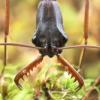Alates are typically released in the late afternoon, 3pm-6pm, on hot and humid (preferably overcast) days. Alates congregate and mate in specific locations, such as under a particularly tall tree, shady overhang, or small clearing. Queens shed and dig their founding chambers in spots that usually have shade (or shade nearby) provided by hardwoods trees such as oak, which provide them with preferred fungus growing mediums such as oak catkins and caterpillar frass. Random founding queens can be found in a lot of sandy places but in certain “hotspots” several dozen queens can dig their founding chambers in very close proximity.
In Central Florida the largest and most concentrated flights take place in late May up until early June, though smaller flights can occur as late as August.
Edited by 123LordOfAnts123, June 20 2020 - 5:16 PM.
















